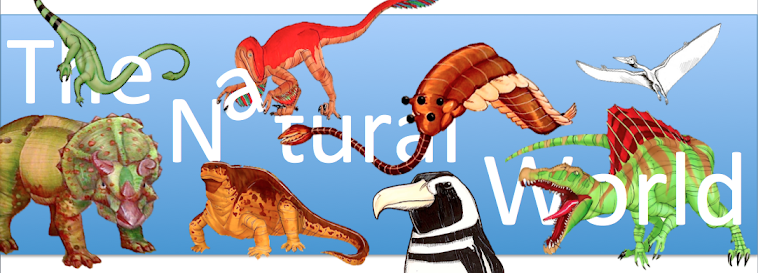400 millions years ago (MYA), during the
Devonian Period, life had already gained a foothold on land. However, in the seas, unless you were at the top of the food chain, there were a lot of predators to contend with. If you were a
fish in the middle of the food chain during the Devonian, you not only had to deal with ancestors of the modern day
shark, but a now-extinct group of armor-plated fish, called the Placoderms. Some of these Placoderms, like
Dunkleosteus, grew to simply enormous proportions, around 30 feet in length! One type of fish that lived during the Devonian and was most likely preyed upon by the sharks and the Placoderms was a fish known as the
Coelacanth.
The
Coelacanth (SEE-lah-canth) was a relatively unassuming fish, its closest living relative being the lobe-finned fish. Fossils of the Coelacanth have been discovered ranging from 400 MYA to around 65 MYA, coinciding with the death of the
dinosaurs. In 1938, however, when one was hauled in on a fishing net off the coast of
South Africa, the temporal range of this animal was extended by 65 million years! Today, by studying the living Coelacanth, scientists have found that the fish gives birth to live young, unlike other fish. Further discoveries both in
Africa (off the coasts of
Mozambique,
Madagascar,
Kenya and
Tanzania) as well as
Asia, around
Sulawesi,
Indonesia, of living Coelacanth specimens have further widened the current geographical range of the Coelacanth.
 |
| A specimen of the Cretaceous coelacanth Coccoderma nudum from Germany. On display at the Mace Brown Museum of Natural History on the campus of the College of Charleston in South Carolina. |
Unfortunately for this living fossil, it is labeled "
Critically Endangered" by the
IUCN, much like yesterday's living fossil, the
mountain pygmy possum. Just like the mountain pygmy possum, conservationist groups are working towards it's protection, trying to keep fisherman from fishing in the Coelacanth's habitat. Hopefully, humans won't be the final nail in the coffin, so to speak, for this 400 million year old fish.


Mmorpg Oyunlar
ReplyDeleteInstagram takipci satın al
tiktok jeton hilesi
tiktok jeton hilesi
antalya saç ekimi
instagram takipçi satın al
ınstagram takipçi satın al
mt2 pvp serverler
instagram takipçi satın al
nft nasıl alınır
ReplyDeleteuc satın al
en son çıkan perde modelleri
en son çıkan perde modelleri
özel ambulans
minecraft premium
lisans satın al
yurtdışı kargo
Good content. You write beautiful things.
ReplyDeletemrbahis
sportsbet
mrbahis
sportsbet
taksi
vbet
korsan taksi
hacklink
vbet
sms onay
ReplyDeleteQUW
erzurum
ReplyDeletekuşadası
ümraniye
beşiktaş
ataşehir
4SAA
https://saglamproxy.com
ReplyDeletemetin2 proxy
proxy satın al
knight online proxy
mobil proxy satın al
TGG
adapazarı
ReplyDeleteadıyaman
afyon
alsancak
antakya
TİPAW